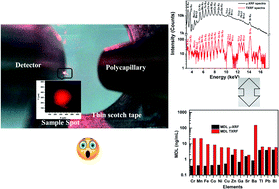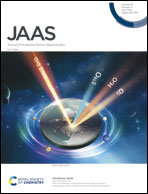Drastic improvement in detection limits in energy dispersive X-ray fluorescence geometry utilizing micro-focused bremsstrahlung excitation in thin-film sample specimen†
Abstract
An excellent improvement in the detection limit is achieved using a lab-based micro-X-ray fluorescence (micro-XRF) spectrometer equipped with a low-power X-ray tube that utilizes the entire bremsstrahlung spectrum emitted from the tube, for excitation. The beam was further passed through polycapillary optics in order to focus it over a spot of 35 μm × 50 μm. The minimum detection limit (MDL) achieved using the present methodology is down to 0.4–4 ng mL−1 for elements ranging from medium to high Z. For some elements, the as-obtained MDL is almost 6–60 times lower than that obtained using the lab-based total reflection X-ray fluorescence (TXRF) spectrometer using the same excitation source. This is the lowest detection limit achieved to date using lab-based XRF instrument in energy dispersive X-ray fluorescence (EDXRF) geometry to the best of our knowledge. Further, the instrumentation is very simple, straightforward and does not involve any complicated alignment procedure as in the TXRF geometry. The developed methodology requires deposition and drying of only 5 μL of the liquid sample specimen on a thin transparent scotch tape to form a thin film sample specimen and it can be directly used for measurements. Using this methodology, we could determine trace elemental concentration in water samples at an ultra-trace level (few ng mL−1) without any complicated pre-concentration or alignment procedure. As the developed methodology is very simple and less time-consuming, it is comparable with the TXRF technique for the routine analysis of different water samples with elements present at ultra-trace levels.



 Please wait while we load your content...
Please wait while we load your content...